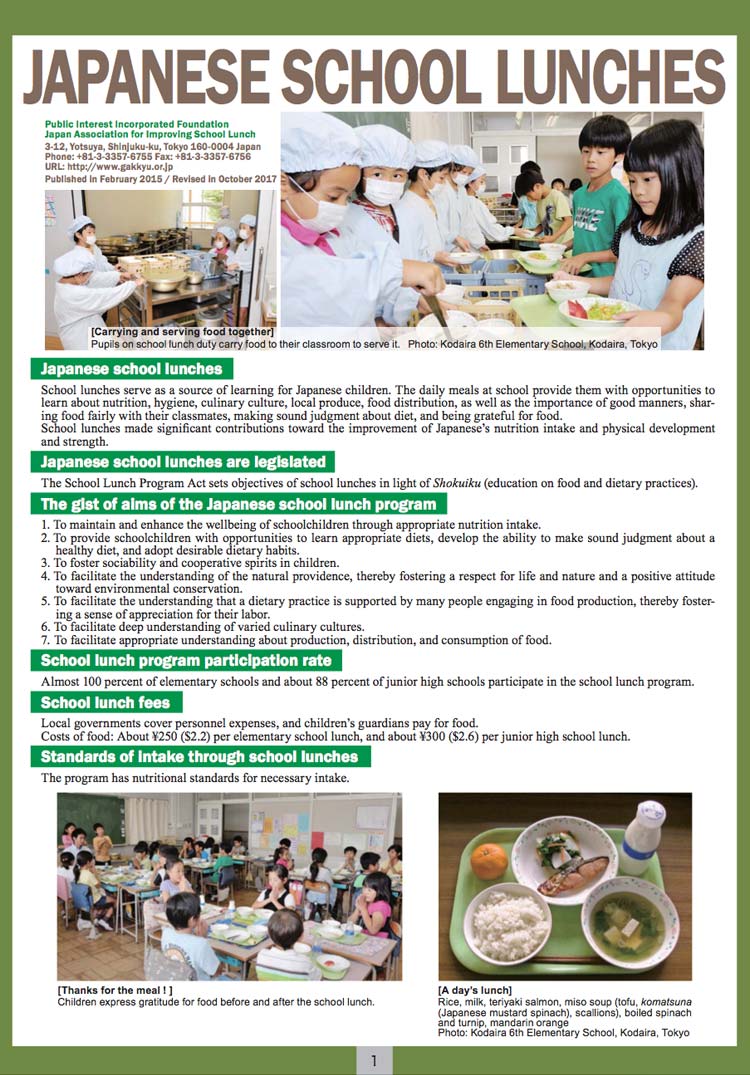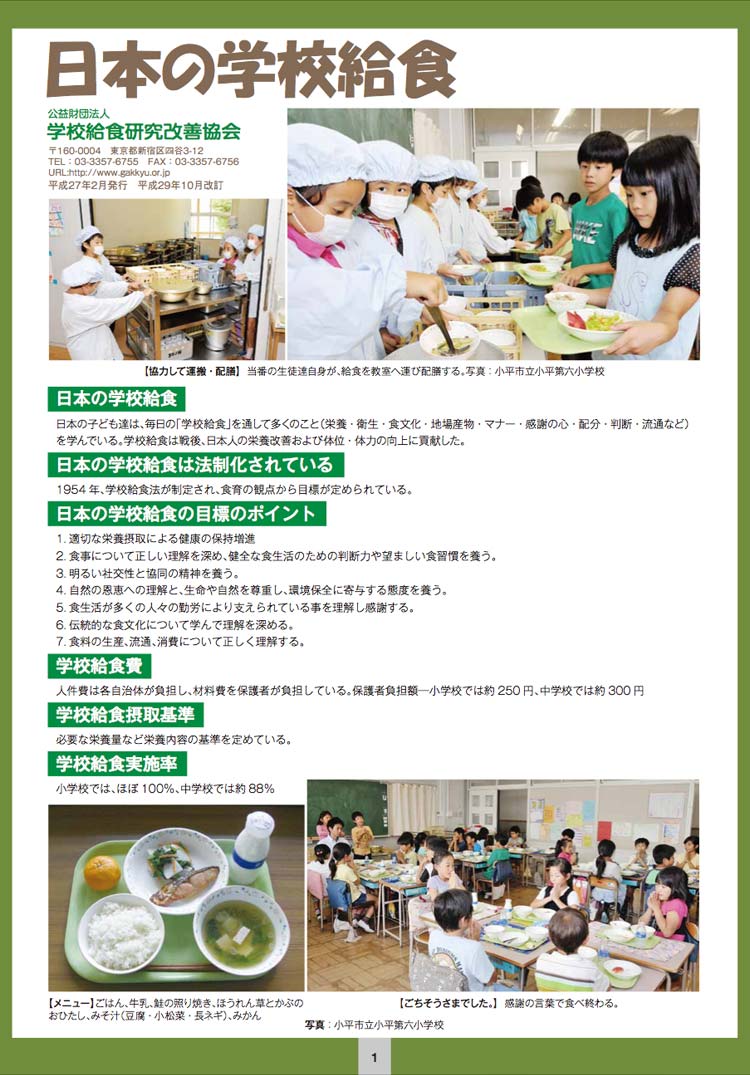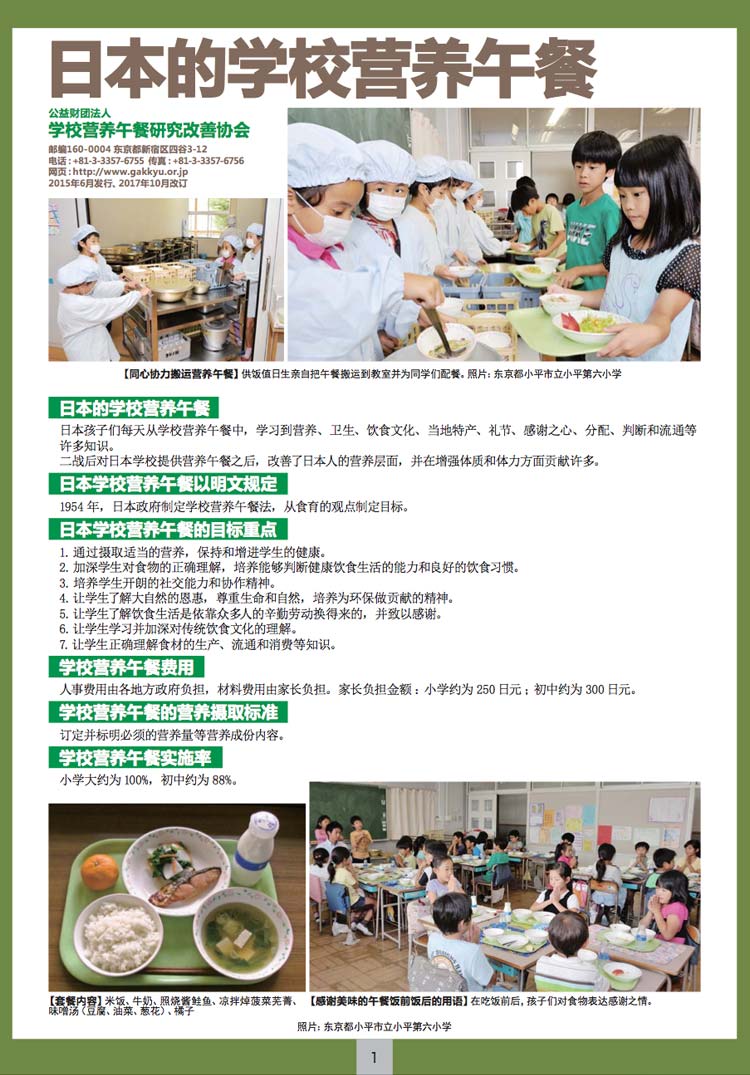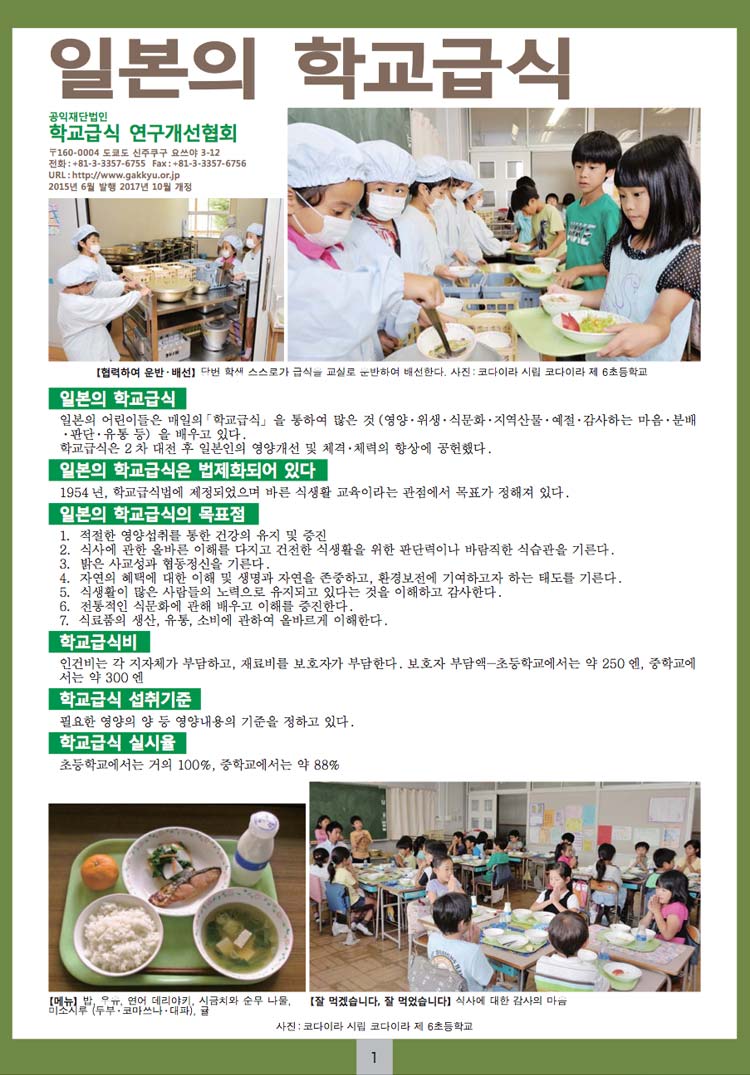We support healthy development of mind and
body of children through school lunches.
Through school meals Children's mind and body I will support a healthy growth
JAPANESEAbout Us
Message from the President
The Public Interest Incorporated Foundation Japan Association for Improving School Lunch was established in 1960 and became a public interest foundation in 2011, and right from its inception, the association has been consistently implementing the purport of its establishment - “activities to protect the mental and physical health of precious children through school lunch.”
The social environment surrounding dietary habit has changed rapidly in recent years, and children’s imbalanced nutritional intake, their irregular lifestyle habits, as well as obesity and underweight are being increasingly pointed out. This has further increased the importance of the role being played by school lunches.
Against this background, it became more important than anything else to promote food related guidance so that children will develop rich humanity and acquire the zest for life. The Basic Act on Food Education was thus enacted in 2005, and various legal improvements in relation to the Act has been underway since then.
As a dietary education promotion project that is based on the objective of its establishment, the association is supporting the initiatives of diet and nutntion teachers and school nutritionists, who play the most important role at the center of dietary education at schools, and to improve their quality. The association is implementing a series of activities and is working towards spreading and enhancing school lunches, which is imperative for enhancing the health of children.
We hope the association’s initiatives help the people involved and the society as activities that contribute to the sound mental and physical growth of children who are the bearers of this country’s future.
Soichiro Tanaka
Name
Public Interest Incorporated Foundation Japan Association for Improving School Lunch
Address and contact information
5F, Paddy Isle Catherina Bldg.
1-18-9 Shinjuku,
Shinjuku-ku, Tokyo, 160-0022, Japan
+81-3-3357-6755
+81-3-3357-6756
Objective
We at Public Interest Incorporated Foundation Japan Association for Improving School Lunch research, improve, and supply school lunches and lunch materials. At the same time, we subsidize the school lunch business and promote dietary education on school lunches and the healthy growth of schoolchildren. By doing so, we aim to contribute to the development and improvement of the school lunch business and nurture schoolchildren’s sound mental and physical growth.
Activities
The foundation carries out the following projects with the primary aim of promoting school lunches and dietary education.
- Promoting dietary education
- Providing subsidies related to the school lunch business
- Researching and studying the conditions surrounding school lunches
- Researching and studying school lunch materials and the supplies thereof
- Conducting other related activities
Established
November 1, 1960
The foundation was established by the nine leaders, including Fujimaro Kubota, who founded the school lunch project at the Ministry of Education, Kunitaro Arimoto, the director of the National Institute of Nutrition (currently the National Institute of Health and Nutrition), and Giichi Ariyoshi, the president of SN Foods Co., Ltd., as a private organization designed to contribute to the improvement and enhancement of school lunches in Japan.
July 9, 1962
The foundation was approved by the Ministry of Education as an incorporated foundation in accordance with Article 34 of the Civil Code.
March 25, 2011
The foundation was approved by the Prime Minister as a public interest incorporated foundation in accordance with Article 44 of the Act on Authorization of Public Interest Incorporated Associations and Public Interest Incorporated Foundation.
April 1, 2011
Public Interest Incorporated Foundation Japan Association for Improving School Lunch was established.
Founding purpose
The provision of school lunches in Japan officially began in 1941 on the order of the Ministry of Education, but the onset of World War II brought about a temporary suspension of school lunch service. Provision resumed after the war in 1946 via an official notice, titled “Encouragement of school lunch promotion,” by the three Ministries of Education, Welfare, and Agriculture and Forestry.
With the US government also providing assistance from 1950 onward, the program evolved into a complete lunch system. However, the Government Appropriation for Relief in Occupied Area Fund (GARIOA), which was the source of the assistance, was discontinued at the end of June 1951.
The School Lunch Program Act then took effect in June 1954, establishing the implementation structure for school lunches. Tireless efforts by the Ministry of Education have made the school lunch structure an integral part of education. The passage of time has brought challenges, however; in fiscal year 1960, for example, school lunches were on the brink of discontinuation for a variety of reasons.
School lunches have been making immeasurable contributions in education, such as improving the physique of students—who represent the next generation—as well as reforming dietary lifestyles and spreading knowledge of nutrition.
The future of school lunches in Japan depends on cooperation across society, including the domestic public and private sectors. To further improve the effectiveness of school lunches in Japan, we need to continue researching the supply of high-quality, nutritious school lunch ingredients from the Japanese agricultural sector and implement a complete school lunch system in a smooth fashion from the country’s unique standpoint.
Public Interest Incorporated Foundation Japan Association for Improving School Lunch was established with that objective.
November 1, 1960
Fujimaro Kubota
Founder and President
Supporting Corporations
The Association receives great support based on understanding and approval of its administrative philosophy and activities.
-
ADEKA CLEAN AID CORPORATION
Alpha Food Co.,Ltd.
-
CRESCO Corporation
-
ECHO Co., Ltd.
-
Fonterra Co-operative Group Limited
FRIGO Co., Ltd.
Fuji Shokuhin Co,. Ltd.
FUKUOKA SEIYU CO., LTD.
-
Heartfoods21. Co., Ltd.
HOKUREN
-
IKEUCHI CO.,LTD
Medical Corporation Imai Clinic
Ina Food Industry Co., Ltd.
-
Kamakura Ham Crown Co.,Ltd.
Kataoka Corporation
-
MACHIDA FOODS Co.,Ltd.
Mafujiya Foods Co., Ltd.
MARUI SYOKUHIN Co., LTD.
Morozumi Jam Co., Ltd.
-
Medical Corporation NAITO HOSPITAL
Nakajima Foods Co., Ltd.
Neige Co., Ltd.
NEU. INC
Nihon Kyushokuhin Co., Ltd.
NIPPON RETORT FOODS Co., Ltd.
NOSUI CORPORATIOM
-
Medical Corporation Okamoto Hospital
Onna Village Fisheries Cooperative
-
PROCTOLOGY CENTER,KUROKAWA UMEDA CLINIC,OSAKA
-
Sanmaruko Foods Co.,LTD
Sanrei Foods Co.,Ltd.
Sanwa Co.,Ltd.
SBS Flec Co., Ltd.
SERIA ROILE CO.,LTD.
Shinozaki Warehouse Co., Ltd.
Shinsei Co.,Ltd.
SN FOODS CO., LTD.
SUGIYO CO., LTD.
-
Takamine Co., Ltd.
TOHNICHI Co.,Ltd.
-
YAMATANE CORPORATION
Projects
The association implements various initiatives to improve school lunches.
Cooking workshops
The association holds cooking workshops for diet and nutrition teachers and school nutritionists throughout Japan.
The objectives of the cooking workshops are as follows:
- The diet and nutrition teachers and school nutritionists use the food products they developed to understand the features of the products, and they develop menu items utilizing the products based on the experience in the workshop.
- Diet and nutrition teachers and school nutritionists study menus and cook the dishes to promote understanding and improvement of cooking skills.
- The workshops are utilized as a forum for the participants, who otherwise have few opportunities to meet due to busy schedules, to exchange information regarding school lunch.

The recipes used at the cooking workshops are posted on the association’s website. The website has an enhanced recipe search function and the recipe can be searched using multiple conditions.
Family Cooking Class
The association co-sponsors school-based and community-based cooking classes for families. Diet and nutrition teachers and school nutritionists who are active in the school lunch field give instructions and conduct the classes.
The objectives of the family cooking classes are as follows:
- The cooking classes offer a forum for the family to think together and solve dietary issues through enjoyable experiences.
- The classes offer cooking experience for children to take interest in food, learn about the activities of those involved in food, gain correct knowledge and basic actions of cooking and apply what they learned in their daily dietary life (including cooking on their own).
- Diet and nutrition teachers and school nutritionists help deepen the involvement of the parents and people from the local community in dietary education.

Comments from the participants
- The recipe was easy and even I was able to prepare it. I would like to cook it also at home. (a fourth grader)
- My child told me that school lunches are good and I was convinced about it once we cooked the same menu items and tasted them. The taste of properly prepared dashi was impressive. I would like to prepare it also at home. (a parent)
Product development
*In collaboration with the School Dietitian Conference of Japan, the association conducts research on foodstuffs for school lunches, develops food products, and inspects the manufacturers’ plants to confirm the products’ quality. These products are sold under the brand of “ZENGAKUEI.”
School Dietitian Conference of Japan: An association made up of diet and nutrition teachers and school nutritionists engaged in work primarily related to school lunches. It carries out projects with the aim of improving the quality of its members.


Supply of skimmed milk for school lunch
The association imports high quality skimmed milk from Australia and New Zealand and offers it through the school lunch associations. Its use is limited to meal services for schools, etc. and is exempted from customs duties as a special measure to enhance children’s health.

School lunch and dietary education drawing competitions
The association conducts drawing competitions on the theme of school lunches and dietary education as part of activities to increase the understanding and for the promotion of school lunches. Winners of past competitions:The fifth competition

“Summer Harvest”
Association President’s Prize
Sakurako Sumitomo
Sixth Grade, Kawata Elementary School, Yoshinogawa City, Tokushima Prefecture

“School Lunch with Friends Tastes Good”
MEXT Minister’s Prize
Mirei Kamiya
First Grade, Tokiwa Elementary School, Gifu City, Gifu Prefecture

“Stir Fried Vegetables – Brimming with Nutrition!”
Special Jury’s Prize for Excellence
Ryo Yoshida
Sixth Grade, Seiwa Special Needs Education School, Nara Prefecture
Special Jury: Koji Kinutani
Professor Emeritus, Tokyo University of the Arts, and Advisor to the association
Participation in various exhibitions
The association engages in activities to disseminate the very important role played by school lunches and dietary education in sound growth of children at various exhibitions targeting both people involved in school lunches as well as the general public.

A mother and her child visiting the annual food education convention participate in a game to learn nutritional balance.
Introduction and dispatch of lecturers
- The association introduces lecturers for seminars and lectures for diet and nutrition teachers and school nutritionists.
- Lectures and talks on the theme of children’s health
-
Food sanitation, hygiene inspections, hygiene instructions, etc.

Japanese school lunch
Japanese children, through their daily school lunches, learn various things including nutrition, hygiene, food culture, local produces, table manners and sense of gratitude. The School Lunch Program Act was enacted in 1954 and school lunches are being provided as part of school education activities.
A brochure explaining Japan’s school lunch program is available here.
Aim of School Lunch
- Maintaining and promoting health through appropriate intake of nourishment.
- Deepen correct understanding of food in daily life, cultivate ability to make judgments for maintaining healthy dietary life and develop desirable eating habits.
- Enrich school life, and develop bright sociability and spirit of cooperation.
- Deepen the understanding that dietary life is reliant on the blessings of nature to develop a mindset that respects life and nature as well as an attitude to contribute to the environmental preservation.
- Develop an attitude that respects labor by deepening the understanding that our dietary life is sustained by the activities of various people involved with food.
- Deepen the understanding of the traditional dietary life of not only Japan but also other regions.
- Lead to a correct understanding regarding production, distribution and consumption of food.
School Lunch Menu

1
2
3
4
The above is a standard menu for a school lunch. In addition, there are special menus consisting of festive dishes.

Users can search for various recipes on the Japanese language site, but the English language site is not provided with the function yet. Those interested in the search system on the Japanese site, please click the following link:
School Lunch Implementation Rate
A high percentage of elementary and junior high schools provide school lunches.

Reference: Ministry of Education, Culture, Sports, Science and Technology website Survey on school lunch implementation status
Diet and nutrition teacher
- Diet and nutrition teacher
Diet and nutrition teacher, through the school lunches, guide students regarding food and manages the daily school lunch in order to promote dietary education in the school.- Guidance related to food
- Give instructions to individual children regarding obesity, unbalanced diet and food allergies.
- Give instructions regarding collective meals by collaborating with homeroom teachers and others during class activities, regular classes and school events.
- Act as a liaison and coordinator among other teachers and staff, as well as households and the local community members, to promote guidance regarding food in collaboration with these people.
- Management of school lunch
Nutrition management, hygiene management, food inspection, supplies management, etc.
- Guidance related to food
-
Appointment status
Diet and nutrition teacher is not a mandatory appointment, but is appointed based on the judgment of the local government or the school administrator. As of 2017, more than 6,000 diet and nutrition teachers are in active service.
Dietary education through team teaching
School lunch nutrition standards per pupil/student per meal
Based on the Results of the Survey on the Meal Situation of Children, etc. conducted by the Ministry of Health, Labour and Welfare, the Council of Collaborators in Studies and Research on School Lunch Nutrition Standards was set up in the Ministry of Education, Culture, Sports, Science and Technology. Based on a report by this Council, the Standards for Provision of School Lunches were revised according to the following table on April 1, 2021.
School lunch nutrition standards per pupil/student per meal
Before revision → After revision(the changed part is in red)
April,2021
| Category | Standard value | ||||
| Pupil (6 years old to 7) | Pupil (8 to 9) | Pupil (10 to 11) | Student (12 to 14) | ||
| Energy (kcal) | 530 | 650 | 780 | 830 | |
| Protein (%) | 13% to 20% of the total energy intake from school lunch | ||||
| Fat (%) | 25% to 30% of the total energy intake from school lunch | ||||
| Sodium (salt equivalent) (g) | under 2 → under 1.5 | under 2 | under 2.5 → under 2 | under 2.5 | |
| Calcium (mg) | 290 | 350 | 360 | 450 | |
| Magnesium (mg) | 40 | 50 | 70 | 120 | |
| Iron (mg) | 2.5 → 2 | 3 | 4 → 3.5 | 4 → 4.5 | |
| Vitamin A (μgRAE) | 170 → 160 | 200 | 240 | 300 | |
| Vitamin B1 (mg) | 0.3 | 0.4 | 0.5 | 0.6 | |
| Vitamin B2 (mg) | 0.4 | 0.4 | 0.5 | 0.6 | |
| Vitamin C (mg) | 20 | 20 → 25 | 25 → 30 | 30 → 35 | |
| Dietary fiber (g) | 4 or more | 5 or more → 4.5 or more | 5 or more | 6.5 or more → 7 or more | |
Notes:
- In addition to the items listed in the table, take into consideration the intake requirement regarding the following:
Zinc: Pupil (6 to 7) 2mg, pupil (8 to 9) 2mg, pupil (10 to 11) 3mg, student (12 to 14) 3mg - These intake standards show the nation-wide average and should be applied in a flexible manner taking careful consideration of the real situation of individual health and life activities as well as the actual situation in the local community.
- When determining the menu, take into consideration the appropriate combination of diverse foods.
Scope: Ideal range is ones within the prescribed values
Reference: Ministry of Education, Culture, Sports, Science and Technology website
History of School Lunch
History of School Lunch
LINK
Pamphlets on Japanese school lunch
English Chinese Korean JapaneseExamples of Japanese school lunch featured in overseas media
Washington PostPublications
Japanese School Lunches brochure
This one-page, two-sided A4-size brochure summarizes and introduces Japan’s school lunch, which has been positioned as part of education since its legislation in 1954 to this day.
The brochure is published in Japanese, English, Chinese and Korean.
In particular, the English version has been widely utilized in various ways such as in English classes at junior high schools in Japan. The brochure in other languages are also distributed to involved parties overseas.
Sukoyaka newsletter
The newsletter disseminates information regarding school lunch- and dietary education-related initiatives and activities from various perspectives aimed at sound development of children’s mind and body through school meals.
The association distributes the newsletters not only to public elementary and junior high schools, diet and nutntion teachers and school nutritionists but also to various government ministries and agencies, education boards of prefectures and municipalities, school meal-related parties, teachers colleges and other various institutions and organizations in Japan and abroad for broad utilization.

“Sukoyaka newsletter vol. 18”
This issue looks into the reality and issues of responses to food allergies in school lunches with the aim of promoting the spread and implementation of concrete initiatives for preventing tragic accidents, so that all children can enjoy school lunch free of worries.

“Sukoyaka newsletter vol. 17”
Milk and dairy products are nutritious food indispensable to school lunch for the sound development of children. This issue disseminates the importance of milk and dairy products in an easy-to-understand manner by featuring explanations by specialists on the aims, roles and evaluation of school lunches, milk and dairy products and Japanese-style meals.
Reprinted dietary education picture-story show materials
The original food education-themed picture-story show materials were produced and distributed in the latter half of 1970s to the first half of 1980s by the association. The reprinted version consists of seven stories from the original versions, which were reedited under the supervision of the School Dietitian Conference of Japan to reflect current teaching contents.
The seven stories enable children to enjoy learning about food education and are currently widely utilized in the field of education including at schools.

Story 1 “Tracking Food’s Travel”
Where does the food you eat go in your body?
Today, we will follow the food after it enters your body.

Story 2 “Adventure of Baikin (Germ) Prince”
Baikin Prince prances around here and there on a trip to find a comfortable place. However, he faces numerous troubles. What ordeals awaited Baikin Prince?

Story 3 “Milk, the Life Time Friend”
Your school lunch every day comes with milk. That is to support your growth and health. Why is milk good for your body? This story provides the reasons.

Story 4 “A Balanced Diet”
We can get anything we want to eat. Let’s acquire a balanced eating habit through our daily meals.

Story 5 “Great Job! Bean Boy”
Bean Boy wants to grow up as soon as possible and transform into various things. People around the world are paying attention to him.

Story 6 “School Lunch Manners”
It’s time for school lunch. Let’s learn proper table manners and enjoy lunch time.

Story 7 “The Great Midnight Meeting”
Ladies and gentlemen, tonight the representatives of food from around the world gather here and will hold a great meeting. What are they going to discuss?
Emergency Food
Emergency food developed by diet and nutrition teachers
Japan experienced unprecedented damages in the Great East Japan Earthquake that occurred on March 11, 2011. Majority of people in the affected areas faced food shortage in the immediate aftermath of the earthquake. There was also the issue of food supply for children who were forced to remain in schools immediately after the earthquake as well as children with allergies.
In response, diet and nutrition teachers and school nutritionists at schools throughout Japan work together and, based on strict criteria typical of specialists, developed emergency food that would help school children survive for 72 hours till relief supplies arrive.
Zengakuei Kyukyu Curry


The packet contains rice and curry, which is tasty even at room temperature.
Specifications
- Light enough to be carried by teachers (especially female teachers)
- 40 packets per class
150 g/packet x 40 packets/box
250 g/packet x 30 packets/box
Product features
- Does not use any of the 28 specific ingredients containing allergens.
- Incorporates the opinions of those who actually experienced disaster, and the curry includes rice and can be eaten as it is without heating.
- The self-standing pouch can serve as a bowl for eating, can be opened easily even by a child and can be disposed in a compact form. It comes with a spoon.
- Ingredients include non-glutinous rice, sweet corn, potato, carrot, onion, tomato puree, brown beech mushroom, etc., produced in Japan, enabling intake of lots of vegetables.
Zengakuei Kyukyu Konsaijiru (vegetable soup)

Contains lots of vegetables. The soup is thickened so that it can be scooped with spoon.
Specifications
- Light enough to be carried by teachers (especially female teachers)
- 40 packets per class
150 g/packet x 40 packets/box
Product features
- Does not use any of the 28 specific ingredients containing allergens.
- Can be consumed as it is without heating and without water. The soup is made thick so that it doesn’t spill easily.
- The self-standing pouch can serve as a bowl for eating, can be opened easily even by a child and can be disposed in a compact form. It comes with a spoon.
- Ingredients include sweet potato, burdock, carrot, onion, daikon radish, shiitake mushroom, konnyaku, etc., produced in Japan and enables intake of lots of vegetables that tend to lack in diet.
Zengakuei Kyukyu Corn Potage with Brown Rice

Includes brown rice for enjoying the food texture
Specifications
- Light enough to be carried by teachers (especially female teachers)
- 40 packets per class
150 g/packet x 40 packets/box
Product features
- Does not use any of the 28 specific ingredients containing allergens.
- Can be consumed as it is without heating and without water.
- Uses corn, onion, carrot and brown rice produced in Japan, which can be had safely by growing children.
- The self-standing pouch can serve as a bowl for eating, can be opened easily even by a child and can be disposed in a compact form. It comes with a spoon.
Zengakuei Kyukyu Japanese mixed rice with glutinous brown rice


Includes glutinous brown rice for enjoying the food texture
Specifications
- Light enough to be carried by teachers (especially female teachers)
- 40 packets per class
130 g/packet x 40 packets/box
200 g/packet x 30 packets/box
Product features
- Does not use any of the 28 specific ingredients containing allergens.
- Can be consumed as it is without heating and without water.
- Uses sweet potato, burdock root, carrot, shiitake mushroom, konnyaku, etc., produced in Japan, which can be had safely by growing children.
- The self-standing pouch can serve as a bowl for eating, can be opened easily even by a child and can be disposed in a compact form. It comes with a spoon.
Mascot

Designed and conceived by diet and nutrition instructors who had experienced the disaster, with an image that would bring relief to children and students upon receiving the emergency food, even when they are in a tough environment.
Uses the character Kyu, one of the kanji characters of Kyushoku, or school lunch, inside the heart symbol.




